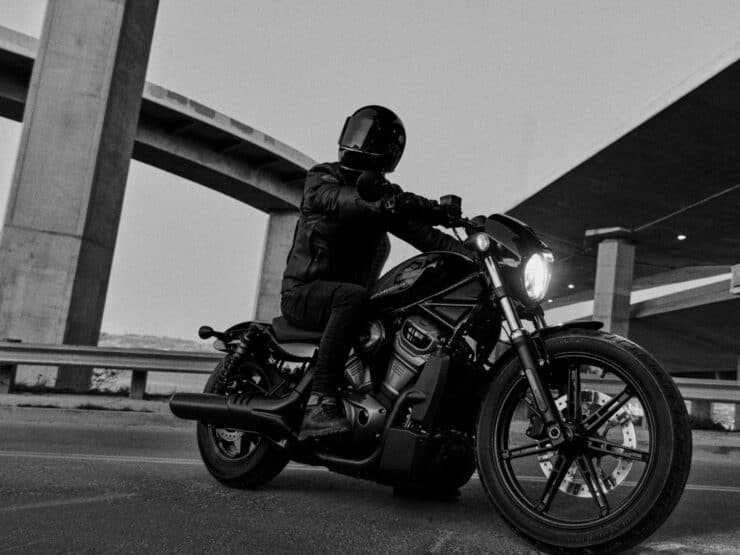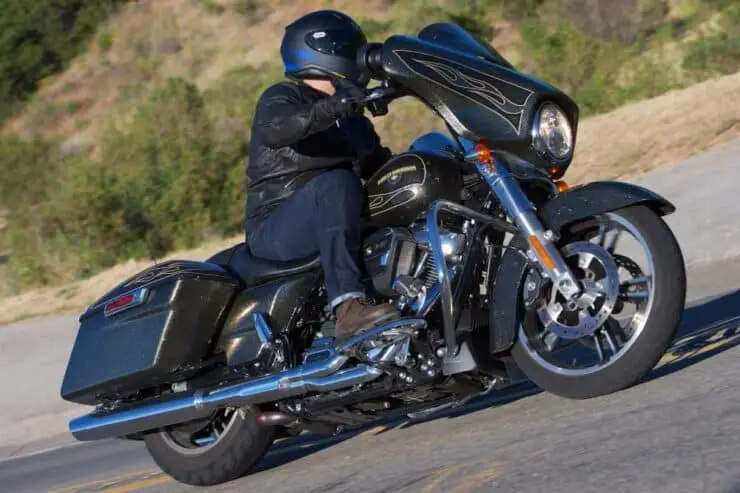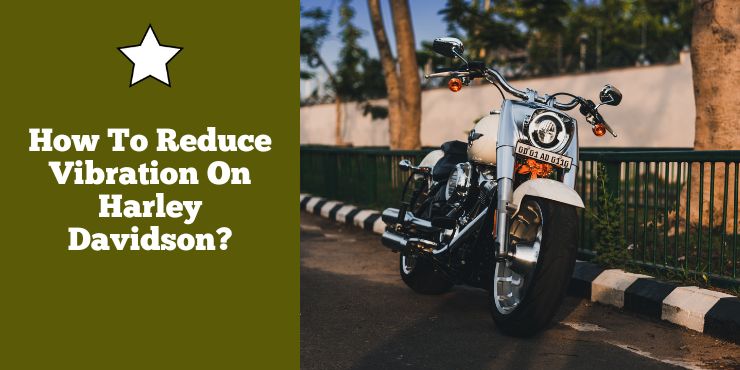Are you a Harley Davidson owner who’s tired of the annoying vibrations coming from your bike? You don’t have to put up with the annoying vibrations any longer!
To reduce vibration, install rubber-mounted handlebars, upgrade to high-density grips, and ensure the engine mount bolts are tightened properly. Balancing the wheels and checking tire pressure can also help.
In this article, we’ll show you 3 simple steps that you can take to reduce vibration on a Harley Davidson. By following these steps, you’ll be able to enjoy a smoother ride and a more peaceful journey! So, if you’re ready to get started, keep reading to find out how to reduce vibration on a Harley Davidson.
Vibration on a Harley-Davidson motorcycle
Harley-Davidson bikes have long been renowned for their iconic designs, powerful engines, and distinct riding experience that perfectly captures the feel and essence of speeding on an open road. One of the underrated aspects that separate Harley-Davidson bikes from their competitors is the unique vibration these bikes produce. The prospect of vibration is quite fascinating because as long as it is proper, you’ll get an amazing experience. However, if the vibrations exceed the limit, the experience can quickly turn sour.
Vibration of a Harley engine
Vibration is an inherent characteristic of Harley-Davidson motorcycles and it is often described as a part of the machine’s DNA. When you’re riding a Harley-Davidson bike, you’ll feel the pulsating power of the engine under you, resonating through the footpegs, handlebars, and the entire frame of the bike. This vibration is a result of various factors, including the engine design, engine mounting, and the overall construction of the motorcycle.
Harley-Davidson bikes typically feature V-twin engines, which consist of two cylinders arranged in a V-shape. This design will inherently produce more vibration compared to other engine configurations. The V-degree angle between the cylinders creates a unique firing order, where each cylinder will fire at uneven intervals. This firing sequence will result in the iconic thumping sound and the distinctive vibrations associated with a Harley-Davidson bike.
To maintain the traditional Harley-Davidson look and feel, the engine is mounted to the frame solidly rather than using rubber mounts for vibration isolation. This direct connection between the engine and the frame will allow the vibrations generated by the engine to get transmitted directly to the rider. While this contributes greatly to the authentic Harley-Davidson experience, it can also result in increased rider fatigue during long rides.

Effects of vibration
The vibrations experienced on a Harley-Davidson bike can vary depending on various factors, such as engine size, riding style, motorcycle model, and modifications. Some bikers appreciate the vibrations as they add character and a sense of connection to the bike. The rhythmic pulses can create a feeling of power and control, enhancing the overall riding experience. However, excessive vibration could be a cause of concern for some bikers as it can result in discomfort, fatigue, or numbness during extended rides.
Harley-Davidson recognizes the importance of the rider experience and has continually worked on improving the vibration characteristics of its bikes. Over the years, the brand has implemented different engineering solutions to minimize excessive vibration while preserving the unique feel and sound that defines a Harley.
Harley-Davidson has introduced rubber-mounted engines in various models, such as the Dyna and Softail series, which significantly reduce the transmission of engine vibrations to the rider. The use of rubber mounts helps isolate the engine from the frame, resulting in a smoother and more comfortable ride. These advancements have been well-received by bikers looking for the right balance between the traditional Harley character and reduced fatigue.
Further, Harley-Davidson has also incorporated advanced technologies like counterbalances for reducing engine vibration. These mechanisms use rotating weights that counteract the engine’s natural vibrations, resulting in a much smoother operation without compromising the iconic Harley feel.
There are also aftermarket options like upgraded exhaust systems, vibration-dampening handlebar grips, and seat cushions with enhanced shock absorption that can help mitigate excessive vibration and enhance rider comfort.
Common causes of vibration in a Harley-Davidson motorcycle
The thrill and experience of riding a Harley-Davidson bike is unlike any other. The speed and power are certainly key factors that contribute to the experience, there is also an underrated factor that does not get mentioned enough. This factor is vibration. While the vibration is an important part of the Harley-Davidson heritage, too much of it could harm the riding experience. Understanding the causes of excess vibration can shed light on the situation and help you resolve excess vibration in your Harley. Here are some of the common causes of vibration in a Harley-Davidson motorcycle.
#1. Engine vibration
Harley-Davidson bikes typically feature V-twin engines, which are known for producing substantial vibrations. The V-twin engine configuration consists of two cylinders arranged in a V-shape with a 45-degree angle between them. This design creates an irregular firing order, which results in an uneven power delivery and pronounced vibration. As the engine fires, each cylinder contributes to the overall vibration, which creates a pulsating sensation that is synonymous with the Harley-Davidson experience.
The solid engine mount used in Harley-Davidson bikes plays a key role in transmitting these vibrations to the rider. The direct connection between the engine and the frame will eliminate the use of rubber mounts for vibration isolation. While this design choice will certainly enhance the raw and visceral mounts for a visceral feel that Harley riders appreciate, it will also amplify the perception of vibration, especially during high-rev situations.
Harley-Davidson knows the importance of minimizing excessive vibration without compromising the riding experience that enthusiasts cherish. There are multiple strategies that can be used for mitigating vibration-related concerns in Harley-Davidson bikes.
One of the approaches used by Harley-Davidson is the introduction of rubber-mounted engines in specific models. By making use of rubber mounts between the engine and the frame, the vibrations transmitted to the rider will be significantly reduced. These mounts will absorb and isolate the engine vibrations, resulting in a smoother and more comfortable ride.
Further, advancements in engine technology have led to the integration of counterbalancers in Harley-Davidson motorcycles. Counterbalancers or also known as balance shafts are rotating weights designed for offsetting the engine’s inherent vibrations. These mechanisms will reduce unwanted engine vibrations while also preserving the character and performance associated with Harley-Davidson bikes.
#2. Fuel-air mixture and vibration
The fuel-air mixture plays a major role in the smooth operation of an engine. In the case of Harley-Davidson bikes, the air-cooled V-twin engines are known for their rich fuel mixture, which greatly contributes to their distinct sound and vibration characteristics. The richness of the fuel mixture will ensure optimal cooling and prevents overheating in air-cooled engines.
However, the rich fuel-air mixture will affect the combustion process, resulting in more pronounced engine vibrations. The excess fuel in the mixture will take longer to burn completely, which results in uneven power delivery during the combustion strokes. As a result, the irregular power impulses will translate into increased vibration felt by the rider.
#3. Exhaust system vibration
The exhaust system of a Harley-Davidson bike plays a key role in the overall performance and sound characteristics of the bike. However, it can also contribute to vibrations experienced by riders. The vibrations in the exhaust system primarily stem from two sources – engine pulses and the design of the system itself.
As the engine fires in the Harley-Davidson V-twin configuration, it’ll create powerful exhaust pulses that travel through the exhaust pipes. These pulses carry energy and could cause the exhaust system to vibrate. The irregular firing order of the Harley-Davidson V-twin engine amplifies the engine, resulting in more pronounced vibrations. These vibrations get transmitted through the exhaust system, which can be felt by the rider and passenger.
The design of the exhaust system, including the materials used, the diameter and length of the pipes, and the presence of mufflers or baffles can affect the vibration levels. If the exhaust system isn’t properly designed or if there are structural issues, it can result in resonance and increased vibration. Poorly secured or loose components can contribute to vibrations in the exhaust system.
Harley-Davidson engineers design exhaust systems with careful consideration of pipe length, materials, and baffling to minimize vibrations. By selecting appropriate materials and optimizing the exhaust system design, the brand aims to reduce resonance and dampen vibrations transmitted to the biker.
#4. Tire vibration
Another common cause of vibration on a Harley-Davidson bike is tire vibration. Tires are the direct contact point between the motorcycle and the road surface. Any imperfections in the tires or the road could result in vibrations. There are various factors that contribute to tire vibration such as tire condition and balance, road surface and irregularities, and more.
Worn-out or unevenly worn tires can result in vibrations. As the tread wears down, the tire’s ability to maintain smooth and balanced contact with the road diminishes. This can result in vibration. Moreover, imbalances in tire weight distribution or tire imbalance can result in vibrations at higher speeds.
Road conditions also play a big role in tire vibration. Rough or uneven road surfaces, potholes, and debris can induce vibrations in the tires. When your bike encounters these irregularities, the tires can momentarily lose contact with the road, resulting in vibrations that get transmitted to the rider.
Harley-Davidson recommends regular tire maintenance. This includes proper inflation, regular inspection for wear and tear, and timely replacement. Moreover, ensuring proper wheel balance can minimize tire vibrations. Riders must also exercise caution and adapt their riding style when encountering rough road surfaces or irregularities to mitigate the impact of tire vibration.

How to reduce vibration on Harley-Davidson
Harley-Davidson bikes are popular for their extremely powerful engines and comfortable performance. The unique vibrations these engines produce result in a raw and exhilarating riding experience. While some bikers appreciate the distinctive feel that comes with a Harley’s vibration, excessive vibrations can result in discomfort and fatigue, especially during extended rides. Luckily for Harley-Davidson bikers, there are solutions to this concern. Harley-Davidson has implemented various effective solutions, including balancing the crankshaft, adjusting the fuel-air mixture, and more to reduce vibration and enhance overall riding comfort.
#1. Balancing the crankshaft
The crankshaft plays a key role in converting the reciprocating motion of the pistons into rotational motion, powering the bike. However, inherent imbalances within the crankshaft assembly can generate vibrations. For minimizing these vibrations, Harley-Davidson has employed a process called crankshaft balancing.
Crankshaft balancing will involve strategically adding or removing weight from the crankshaft to achieve better equilibrium. By carefully adjusting the weight distribution, the forces generated during engine operation are balanced, reducing unwanted vibrations. Balancing the crankshaft will not only contribute to a smoother engine operation, it’ll also minimize the transmission of vibrations to the rider, enhancing overall comfort.
Harley-Davidson engineers meticulously analyze the crankshaft assembly and make use of precision techniques for ensuring optimal balance. By addressing crankshaft imbalances, they significantly reduce vibration levels, making the riding experience much more enjoyable and comfortable.
#2. Adjusting the fuel-air mixture
The fuel-air mixture will be another important element in the combustion process that powers the engine. An improper fuel-air mixture will result in inefficient combustion, increased engine vibrations, and reduced performance. Harley-Davidson understands the significance of adjusting the fuel-air mixture to optimize engine operation and minimize vibrations.
In older Harley-Davidson models that have carburetors, achieving the correct fuel-air mixture will involve meticulous tuning. Harley-Davidson technicians carefully adjust the carburetor settings to achieve the ideal air-fuel ratio for smooth combustion. A rich fuel-air mixture where the fuel concentration is higher could contribute to excessive vibrations. By precisely calibrating the carburetor, the air-fuel ratio will be optimized, reducing vibration levels and improving overall engine performance.
Meanwhile, modern Harley-Davidson bikes come equipped with electronic fuel injection systems. These systems make use of sensors to monitor various engine parameters and automatically adjust the fuel-air mixture for optimal combustion. This advanced technology will result in precise control of the air-fuel ratio, resulting in improved fuel efficiency, performance, and reduced vibrations. The electronic fuel injection systems adapt to changing conditions, ensuring optimal combustion, and minimizing unwanted engine vibrations.
#3. Upgrading the exhaust system
The exhaust system of a Harley-Davidson bike plays a critical role in sound, performance, and vibration characteristics. Upgrading the exhaust system on a Harley-Davidson can be an effective solution to reduce excessive vibrations. There are multiple ways bikers can do that including aftermarket exhaust systems, full system vs. slip-ons, and sound dampening.
Aftermarket exhaust systems offer a wide range of options that are designed to improve performance while reducing vibrations. These systems typically feature advanced engineering techniques such as improved flow dynamics, resonance chambers, and dampening materials, which help minimize vibrations. Upgrading to an aftermarket exhaust system can lead to smoother engine operation and a reduction in transmitted vibrations.
Harley-Davidson bikers can also choose between full exhaust system replacements and slip-on mufflers. While slip-on mufflers do offer an easier installation process and other benefits, a full exhaust system replacement will provide more extensive improvements, including better vibration reduction. Full system replacements will typically involve upgrading the headers, mid-pipes, and mufflers, which results in a comprehensive solution to minimize vibrations.
Exhaust systems with sound-dampening features will help reduce vibrations. These systems will incorporate design elements that mitigate resonance and absorb excessive noise and vibrations. Opting for an exhaust system that focuses on sound dampening will significantly improve the riding experience by reducing excessive vibrations without sacrificing the iconic Harley-Davidson sound.
#4. Replacing tires
Tire condition and quality of the tire are also major factors in defining the overall ride quality and vibrations experienced on a Harley-Davidson bike. Replacing tires can greatly contribute to reducing vibrations.
Selecting high-quality tires designed for specific riding conditions will be essential. You should consider tires that offer a balance between grip, comfort, and stability. Moreover, go for tires that are renowned for their vibration reduction capabilities as they’re engineered to absorb road imperfections and minimize transmitted vibrations.
During tire replacement, ensuring proper tire balancing will be crucial. Imbalances in tire weight distribution will result in vibrations at higher speeds. Professional tire balancing techniques should be employed to equalize weight distribution, minimize vibrations, and provide a smoother ride.
Regular tire maintenance will be important for optimal performance and vibration reduction. You must maintain proper tire pressure, inspect tires for wear and damage, and replace worn-out tires promptly. Proper maintenance will ensure a consistent and smooth contact patch with the road surface, minimizing vibrations caused by tire irregularities.

Impact of excessive vibration on a Harley-Davidson bike
While vibration certainly adds to the thrill of riding a Harley-Davidson bike, too much vibration could be problematic. Most bikers appreciate the raw and visceral experience that comes with Harley’s vibrations when you’re revving in the throttle and speeding down the road but excessive vibration can have its drawbacks. Here are some of the drawbacks that you will experience if there is excessive vibration in your Harley-Davidson bike.
#1. Rider discomfort and fatigue
One of the main drawbacks of excessive vibration is the discomfort that it can cause to the rider. Prolonged exposure to strong vibrations can result in increased fatigue and physical discomfort, especially during long rides. The constant vibrations transmitted through the handlebars, foot pegs, and seat can result in numbness, tingling sensations, and muscular strain. This can make the ride less enjoyable and potentially affect your concentration and control.
#2. Reduced riding pleasure
Excessive vibration can also greatly diminish the overall riding pleasure on a Harley-Davidson bike. Riders might find it quite challenging to fully enjoy the experience when the vibrations become a distraction. The excessive shaking can detract from the sense of smoothness and fluidity that riders are after, diminishing the thrill and satisfaction of riding.
#3. Decreased control and handling
Strong vibrations can affect the biker’s ability to maintain optimal control and handling of the motorcycle. Excessive vibrations can result in the rider’s hands becoming fatigued and less responsive. This can impact their ability to steer, brake, and accelerate with precision. This reduction in control can be quite dangerous, especially during critical situations or when navigating challenging road conditions.
#4. Impact on components and longevity
Continual exposure to excess vibration can result in accelerated wear and tear on different components of the motorcycle. Vibrations can affect the integrity of electrical connections, fasteners, and other mechanical parts. Over time, this can result in increased maintenance and repair costs. Moreover, vibrations can contribute to premature fatigue and failure of certain components, potentially compromising the overall longevity and reliability of the motorcycle.
#5. Potential health risks
Sustained exposure to excessive vibration could have potential health risks for bikers. The constant vibrations could cause musculoskeletal issues such as hand-arm vibration syndrome (HAVS) or vibration white finger (VWF). These conditions can manifest as tingling, numbness, and reduced sensitivity in the hands and fingers. Long-term exposure to excessive vibration without appropriate measures could increase the risk of developing such health problems.
Also read: How to Change Handlebars on a Harley?
FAQs
What are the causes of vibration on a Harley Davidson?
Vibration on a Harley Davidson can be caused by a variety of factors, including improper maintenance, engine issues, and tire imbalance. Improperly installed components, worn parts, and loose fasteners can also contribute to vibration.
What are the best ways to reduce vibration on a Harley Davidson?
The best ways to reduce vibration on a Harley Davidson include checking tire balance, inspecting the engine and other components for wear and damage, and ensuring all fasteners are tight. Replacing worn parts with high-quality components can also help reduce vibration.
What should I do if the vibration persists even after I’ve taken steps to reduce it?
If the vibration persists even after taking steps to reduce it, it may be a sign of a more serious problem. In this case, it’s best to take your Harley Davidson to a certified mechanic for a full inspection. They can identify any potential issues and make any necessary repairs or replacements to help reduce vibration.

